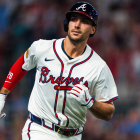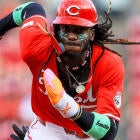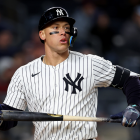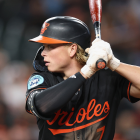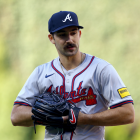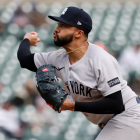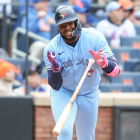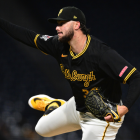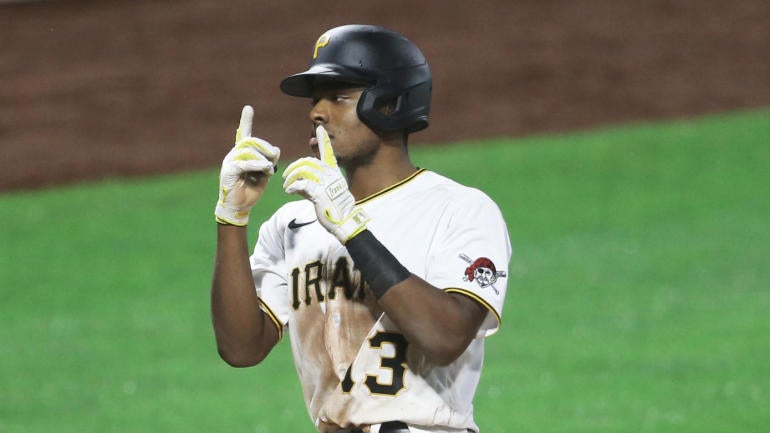
The arrival of the offseason means that it's time to rank stuff. Already this winter, we've sized up the 60 best free agents, both on an overall and positional basis. There's no law that prevents us from ranking minor-league players in addition to their big-league counterparts. As such, we're going to spend the winter evaluating every team's farm system.
The lack of a minor-league season makes that more of a challenge this year. It doesn't help that some teams opted against sharing video and data from their alternate-site camps with the rest of the league. As such, we've opted against overthinking this. Our rankings will essentially be the same as they were last winter with a few changes. First, we'll exclude anyone who graduated by exhausting their rookie eligibility; second, we'll replace them with draftees or other worthy prospects; and third, and lastly, we'll present the information in a new format.
In every article in this series, you'll find a team's top five prospects as well as five others we felt like including, either because of their promise or some other reason. For those top five prospects, you'll find a quick summation of their pros (their saving grace, if one will) and their cons (their fault line), as well as beefier report and our attempt to peg their "likeliest outcome."
These rankings were compiled by talking to industry folks -- scouts, analysts, and other evaluators -- and include a touch of our own evaluative biases. Remember, that this is more of an art than a science, and that the write-ups matter more than the rankings themselves.
Now, let's get on to the top five prospects in the Pittsburgh Pirates system.
Do note that we've excluded ONeil Cruz from the list following his September arrest in the Dominican Republic.
1. Ke'Bryan Hayes, 3B
Age (as of 4/1/2021): 24
Height/Weight: 5-foot-10, 205 pounds
Acquired: 32nd pick in 2015 draft (Concordia Lutheran High School, Texas)
Highest level: MLB
Saving grace: Gold Glove-caliber defense at the hot corner
Fault line: Atypical power production at the hot corner
Scouting report: Hayes is already a high-quality defensive third baseman. His movements are fluid, his hands are soft, his arm is plus, and his range is such that he's going to make a habit out of intercepting grounders and choppers ticketed for the shortstop. (One source pondered if Hayes could cut it at shortstop.) His offensive value is tougher to pin down. Hayes hit double-digit home runs for the first time last year in Triple-A, but that was rabbit-ball-assisted and he did so while providing below-average production overall. He should walk a fair amount, and his above-average speed gives him a chance for a dozen-plus steals. Everyone hits for power these days, though, and Hayes' bat could play a touch light.
Likeliest outcome: Glove-first starting third baseman
2. Travis Swaggerty, OF
Age (as of 4/1/2021): 23
Height/Weight: 5-foot-11, 180 pounds
Acquired: 10th pick in 2018 draft (University of South Alabama)
Highest level: High-A
Saving grace: Well-rounded, up-the-middle profile
Fault line: Underperforming stick
Swaggerty is a five-tool player in the sense that all of his could grade as average or better upon maturation. Oftentimes, those types lack a carrying tool, or are held as positional tweeners. Swaggerty doesn't have to worry about that aspect. His above-average speed and arm strength, among other traits, should allow him to stick in center field for the long haul. Swaggerty's offense demands more of his attention, but he seemed to figure something out midway through 2019: he had a .628 OPS and a strikeout rate around 25 percent through June; beginning with July, he had an .865 OPS and a K rate around 18 percent.
Likeliest outcome: "Swag" Players' Weekend nickname; starting center fielder.
3. Quinn Priester, RHP
Age (as of 4/1/2021): 20
Height/Weight: 6-foot-3, 195 pounds
Acquired: 18th pick in 2019 draft (Cary-Grove High School, Illinois)
Highest level: Low-A
Saving grace: Upside
Fault line: Inexperience
Priester was the first prep pitcher off the board in the 2019 draft, and for good reason. He has everything a pitcher needs to become a big-league starter, including an easy delivery, a big frame, and two potential plus pitches, in his fastball and his curveball. Priester needs to work on his changeup, as is the case with most pitchers from cold-weather states with fewer than 40 professional innings. He has years before that becomes a concerning matter.
Likeliest outcome: Mid-rotation starter
4. Nick Gonzales, MIF
Age (as of 4/1/2021): 21
Height/Weight: 5-foot-10, 190 pounds
Acquired: Seventh pick in the 2020 draft (New Mexico State)
Highest level: NCAA
Saving grace: Hit tool
Fault line: Power potential and defensive position
Gonzales hectored WAC pitching in the spring before the pandemic shut down everything. In 82 plate appearances, he was batting .448/.610/1.155 with 12 home runs and 11 more walks than strikeouts. He can hit, but one concern about his game is that he might not slug enough (based on his collegiate exit velocities) to live up to the comparisons he's received to Brewers second baseman Keston Hiura. Another concern is that he's stretched too thin defensively at shortstop. That combination could leave him as a solid player, albeit not a middle-of-the-order staple.
Likeliest outcome: Gap-hitting second baseman
5. Liover Peguero, SS
Age (as of 4/1/2021): 20
Height/Weight: 6-foot-1, 160 pounds
Acquired: Part of the Starling Marte trade (Diamondbacks)
Highest level: Low-A
Saving grace: Well-rounded contributor
Fault line: Volatility
Peguero, 20 come New Year's Eve, may well occupy a higher spot in a year's time. He has a thicker lower half, but he's developed into a fine defensive shortstop thanks to his above-average speed and arm. There's a chance he's an above-average hitter, too, though he could stand to work on his approach. Peguero's outcome cone is too wide to rank him higher than this -- he is a teenage shortstop, after all -- but there's a lot to like and dream on here.
Likeliest outcome: Starting middle infielder?
Five others to know
- Brennan Malone, RHP
Malone is the other player the Pirates received in exchange for Marte. He's a physical right-hander with the potential to move into the top five, and, more importantly, to stick in the middle of a rotation. By the time he graduates, his arsenal could feature four average or better offerings, beginning with an above-average fastball-slider tandem. Malone turned 20 years old in September, and he's yet to spend a real season in the organization, so he's a ways off.
- Tahnaj Thomas, RHP
Cleveland's front office usually knows what it is doing with pitchers, but execs might regret the trade that sent Thomas (and Erik Gonzalez) to Pittsburgh for Jordan Luplow and Max Moroff. Thomas, who turned 21 in June, has a live arm that is capable of producing 100 mph; a promising slider; a broad frame with the potential for added muscle; and a ton of athleticism. There's a lot to like here, even if he needs to further improve his command and changeup.
- Carmen Mlodzinski, RHP
Mlodzinski (that's "ma-Jinsk-ee") was limited to 35 innings combined in his sophomore and junior seasons by a broken foot and the pandemic. He finished his Gamecocks career with a 4.74 ERA. It didn't matter. Scouts were still taken by his athleticism, his impressive stint in last summer's Cape Cod League, and his potential for three above-average offerings (mid-90s sinker, slider, and cutter). Mlodzinski has a repeatable delivery that should enable him to have good control. He'll need to prove he can consistently miss bats or manage contact against advanced hitters. If he can do either, then he ought to grow into a mid-rotation starter.
- Cody Bolton, RHP
Bolton has a disagreeable profile. There's reason to think he'll end up in the bullpen over the long haul, but there's no incentive to hasten that outcome. He has a starter's frame and two above-average pitches: a fastball (that has gained steam in recent years) and a slider. He's also only eight months older than Mlodzinski. What Bolton doesn't have is a clean medical history or an aesthetically pleasing delivery: he combines a drop-and-drive motion with a long arm swing on the backside. If the Pirates were planning on competing anytime soon, speeding Bolton along to a big-league setup role would make sense. They aren't, so it doesn't.
- Jared Jones, RHP
Jones, yet another 2020 draftee yet to make his professional debut, has 'ball in his blood. His father and two cousins played professionally, while his mother was a collegiate softball player. Unsurprisingly, he's a good athlete who runs and throws well enough to attract some interest as an outfielder. Jones' future for now is on the mound, where he can touch into the upper-90s and unleash an at-times above-average slider. He's listed at just 6-foot-1, so expect to hear some comparisons to other short right-handed starters, like Marcus Stroman and Johnny Cueto, should things go well. As an added bonus, he even tweaks his delivery to disrupt the hitters' timing, much the way Stroman and Cueto have done throughout their careers.
![[object Object] Logo](https://sportshub.cbsistatic.com/i/2020/04/22/e9ceb731-8b3f-4c60-98fe-090ab66a2997/screen-shot-2020-04-22-at-11-04-56-am.png)










